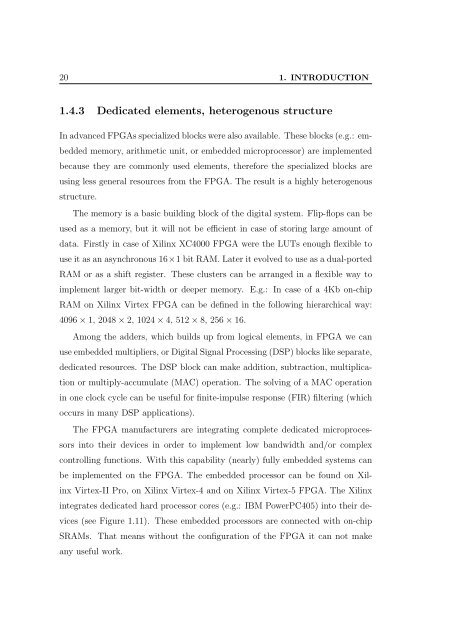PPKE ITK PhD and MPhil Thesis Classes
PPKE ITK PhD and MPhil Thesis Classes
PPKE ITK PhD and MPhil Thesis Classes
You also want an ePaper? Increase the reach of your titles
YUMPU automatically turns print PDFs into web optimized ePapers that Google loves.
20 1. INTRODUCTION<br />
1.4.3 Dedicated elements, heterogenous structure<br />
In advanced FPGAs specialized blocks were also available. These blocks (e.g.: embedded<br />
memory, arithmetic unit, or embedded microprocessor) are implemented<br />
because they are commonly used elements, therefore the specialized blocks are<br />
using less general resources from the FPGA. The result is a highly heterogenous<br />
structure.<br />
The memory is a basic building block of the digital system. Flip-flops can be<br />
used as a memory, but it will not be efficient in case of storing large amount of<br />
data. Firstly in case of Xilinx XC4000 FPGA were the LUTs enough flexible to<br />
use it as an asynchronous 16×1 bit RAM. Later it evolved to use as a dual-ported<br />
RAM or as a shift register. These clusters can be arranged in a flexible way to<br />
implement larger bit-width or deeper memory. E.g.: In case of a 4Kb on-chip<br />
RAM on Xilinx Virtex FPGA can be defined in the following hierarchical way:<br />
4096 × 1, 2048 × 2, 1024 × 4, 512 × 8, 256 × 16.<br />
Among the adders, which builds up from logical elements, in FPGA we can<br />
use embedded multipliers, or Digital Signal Processing (DSP) blocks like separate,<br />
dedicated resources. The DSP block can make addition, subtraction, multiplication<br />
or multiply-accumulate (MAC) operation. The solving of a MAC operation<br />
in one clock cycle can be useful for finite-impulse response (FIR) filtering (which<br />
occurs in many DSP applications).<br />
The FPGA manufacturers are integrating complete dedicated microprocessors<br />
into their devices in order to implement low b<strong>and</strong>width <strong>and</strong>/or complex<br />
controlling functions. With this capability (nearly) fully embedded systems can<br />
be implemented on the FPGA. The embedded processor can be found on Xilinx<br />
Virtex-II Pro, on Xilinx Virtex-4 <strong>and</strong> on Xilinx Virtex-5 FPGA. The Xilinx<br />
integrates dedicated hard processor cores (e.g.: IBM PowerPC405) into their devices<br />
(see Figure 1.11). These embedded processors are connected with on-chip<br />
SRAMs. That means without the configuration of the FPGA it can not make<br />
any useful work.






![optika tervezés [Kompatibilitási mód] - Ez itt...](https://img.yumpu.com/45881475/1/190x146/optika-tervezacs-kompatibilitasi-mad-ez-itt.jpg?quality=85)









